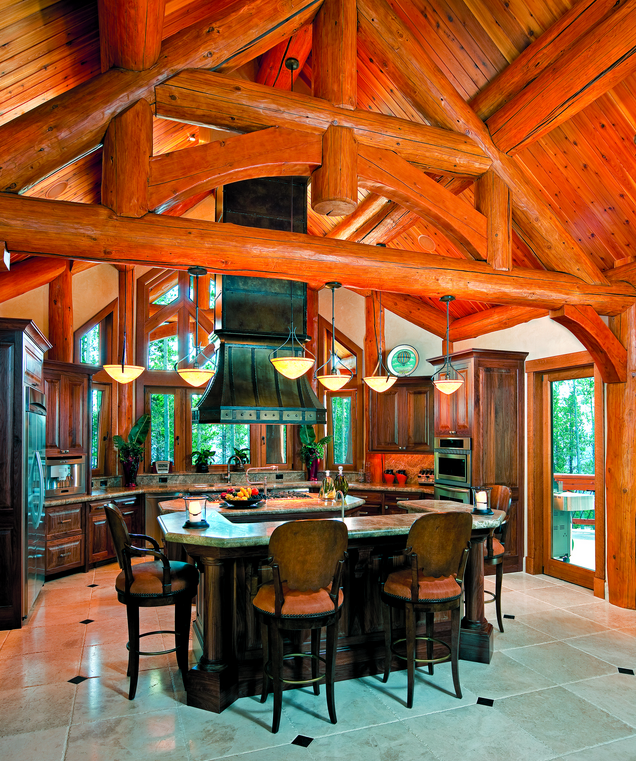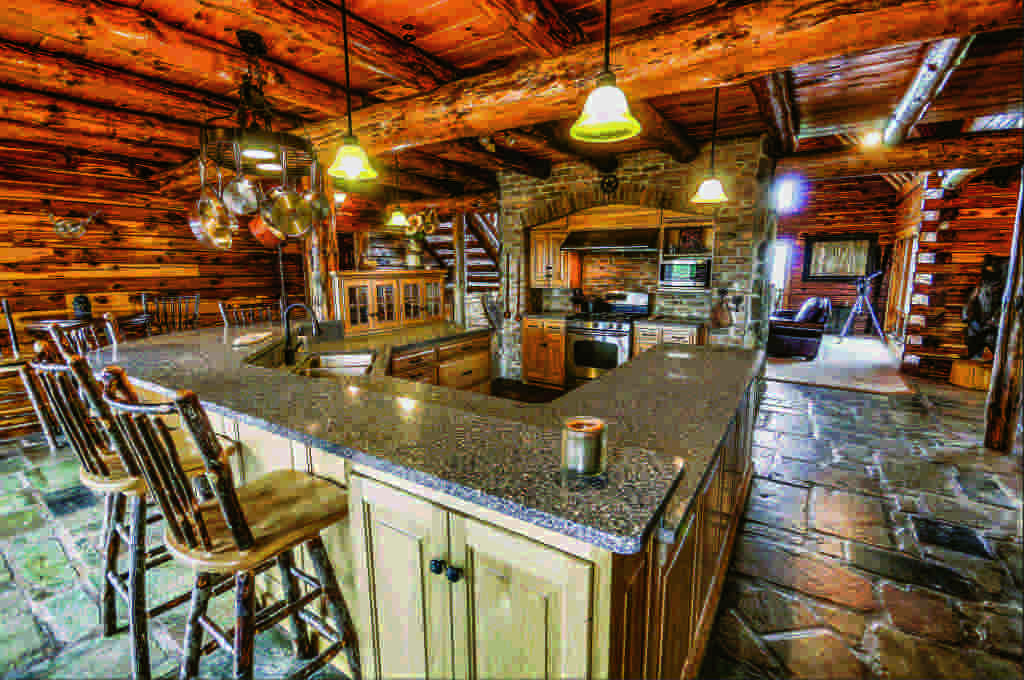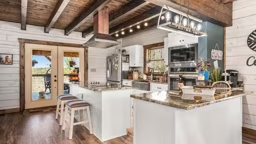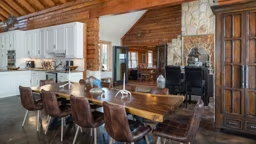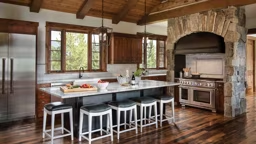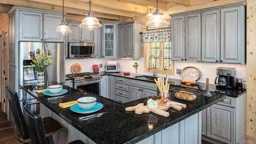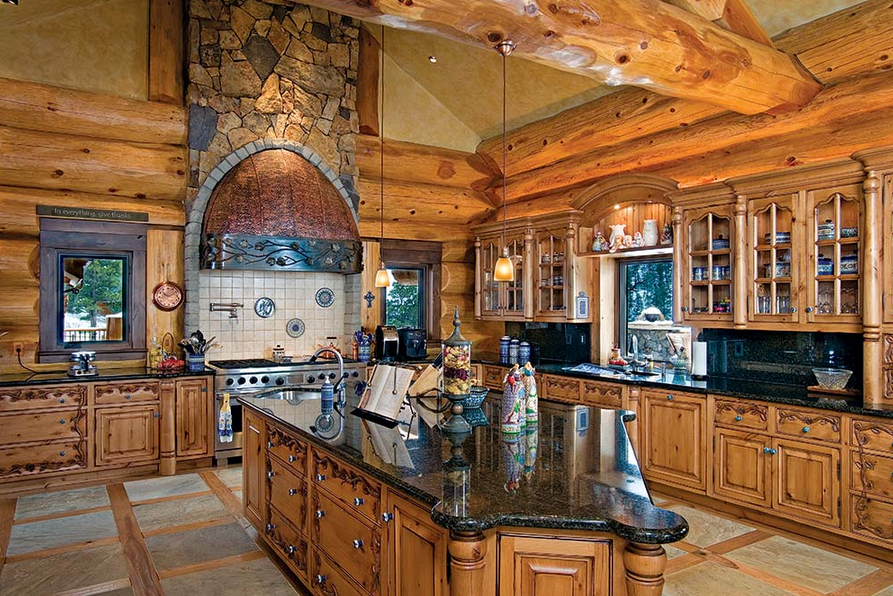
The style considerations will come later. To get the kitchen you need, you want to pose the right questions before you start construction. A good place to begin is to ask yourself these two things: "What features do I like about my current kitchen?" and "What problems do I have with it?" Once you've made that initial list of dos and don'ts, there are some other points to consider.
Who's Cooking?
Before you pick out appliances and countertops, take the time to reflect on who will use your kitchen. Is there a primary cook and a primary cleaner, or are both functions shared? Does the family often cook together? How many family members will be cooking, and what are their ages and heights? Are they left- or right-handed? These factors affect everything from storage options to basic dimensions.For instance, if one person cooks, you'll need a walkway at least 42 inches wide between your main counter and the opposite wall or island, says Connie Edwards, a certified kitchen designer and design director for American Woodmark Corp. But for two people, she says, you'll want a 48-inch-wide path. If children cook as well as adults, you may want countertops of varying heights.
Another issue: Do you prefer to be alone in the kitchen during meal preparation, or do you like to have a helper or talk with family or friends while you cook? If the second option works for you then an island may be ideal. It provides a place for guests to set down a glass, and serves as a handy barrier to keep them from getting underfoot.
Cooking Style, Living Style
The type of cooking you do has a big impact on your kitchen design. Say you're a perfunctory weekday cook who goes all out on the weekends with big parties. You'll probably want serving space and entertainment-related features like warming ovens. Alternatively, if you do everyday cooking for a large, busy family, you may want a bigger-than-usual food prep area and a smaller island (or none at all) to allow room for many helpers. If you're someone who leisurely concocts gourmet meals for two, you might want to design your kitchen so your spices and special-purpose cookware are easily accessible.Your style of cooking, in turn, influences how you buy and store food. If you buy in bulk for a big family, you may want a large pantry off the kitchen. Also, if you live in the country and sometimes are snowbound, you'd be wise to plan lots of food storage. During the planning phase of your kitchen is the time to think about other special spaces you may need, like added surface area and storage for canning, for example, a window box for herb growing or room for wine storage or cookbooks. If you spend your kitchen time baking, you may want a niche outfitted with a marble counter at a low enough height to comfortably knead and roll out dough. In one kitchen she designed, certified kitchen designer Kathye Conti had countertops at five different heights. "It all depends on the number of cooks and the size of the kitchen," she says.
Cooking isn't all you need to consider. In recent years, the kitchen has returned to its roots as the center of the home, bringing back many non-food activities. For example, homework and bill paying may be part of the mix in your kitchen. Or maybe you'll need a built-in desk or computer work station. Or, if you're a recycler, you may need to provide room to store your containers.
Access and Maintenance
Just watch any restaurant chef at work and you'll see why commercial kitchens have open shelves and hanging pots. These features simply make it easier to reach tools and cookware quickly. That's why in recent years, many kitchen designers have adopted some of those principles for residential kitchens, right down to the use of stainless steel appliances and commercial grade materials. You may not want to build a restaurant kitchen, but you could consider some built-in open space for plates or possibly glass-front cabinets and roll-out shelves for easy access.Don't forget to think about small features like the hardware on your cabinets and drawers. "You want something that's easy to grasp," says Connie. "If you're a serious cook, you want to be able to open a drawer with a little finger." And if you do a lot of cooking, it's important to pick good quality materials so they'll stand up to frequent use.
When it comes to cleaning, even a tidy cook needs surfaces that are easy to maintain. For hardware or cabinets, that means you'll want to stay away from styles with grooves where dirt could hide. When considering appliances, look for finishes that won't show fingerprints. For example, the new brushed stainless steel is a better option than standard stainless. Also consider which wall areas might be subject to stains and install back splashes. This is especially important around the sink and stove. Cleanup considerations can also influence your room's design. "Cooking tends to be a messy sport," says Connie. "You're going to want enough decorative elements to draw the eye away from the clutter," You may even want 42-inch-high-walls on your island to hide the mess from guests in adjoining rooms. It's a space that's ideal for cookbooks. Underneath your feet, tile is excellent kitchen flooring because it's easy to clean, particularly if you've sealed the grout. But hard tile floors are unforgiving on backs and knees. If you plan to spend hours standing in the kitchen, consider real linoleum instead, suggests Deborah. Or try her personal flooring favorite, cork. Bamboo, along with some of the new laminate flooring options, also compress a little, giving your bones relief.
Storage and Efficiency
The average kitchen has 12 small appliances. But if you're a serious cook, you'll likely have more. If so, consider installing an appliance garage. This is a specialty cabinet with doors that sits on the counter or at counter level. It's perfect for storing a mixer and food processor, as well as specialty items like a berry press and pasta machine. And it keeps your small appliances out of sight yet easy to reach, says Kathye. Serious cooks also tend to need more room than the average person does for specialty pieces like fish platters and large serving trays. And they nearly always need more room for cutlery.The design of your storage space impacts efficiency in your kitchen, too. For instance, it doesn't do much good to have lots of storage space if the items and appliances you use most frequently are scattered around the kitchen. "Real cooks like to move fast," says Kathye. Even in a large kitchen, she says, some cooks prefer a very small work triangle with appliances close together so they can move around efficiently. In any work space — your kitchen included — having the right equipment in logical locations is the key to efficiency. Among the features you might include are a deep sink; a second source of water near the cooktop; a second sink that enables two people to work without getting in each other's way; a tiled surface beside the stove where you can place hot pans; a pot-filler tap for stock pots; and maybe even a second garbage disposal. You'll also may want to choose a full-size range hood over the less powerful downdraft styles that are integrated into many cooktops.
Light From the Start
Lighting is often an afterthought in many kitchen plans, yet it's as important as any other element. You want as much natural light as possible, says Deborah, so if it's feasible to add a skylight or enlarge a window, do it. "Almost every kitchen is underlit," she says, adding that people over the age of 50 need 100 percent more light than younger household chefs. To add light, Connie suggests installing sconces to brighten darker corners and wiring pendant lights over your kitchen island. This is particularly important in kitchens with high ceilings. "Make sure that you have enough lighting in both the general and the task area," she says. If you want to alter lighting to control the mood, install dimmers. Put the lights up when you're cooking and down for entertaining. Like every other space in your home, your kitchen must work for you. "For a cook, function is everything," says Kathye. "Just ask yourself: 'What's important to you?' "Take it up a Notch!
Are you looking for some special accents to spice up your kitchen? Consider these high-end products.Miele offers an oven, powered by steam, designed to offer a healthier, more flavorful method of cooking while saving time over conventional ovens. You can cook without using oils or sauces to retain moisture, and the oven also defrosts and reheats. Three shelves simultaneously cook food without transferring flavor from one to the next.
Designed for the serious cook, this PRO CookSink is a 15-inch stainless steel unit featuring a cooking vessel and water supply for efficient food preparation and clean up. Optional accessories include the steamer and double boiler, sauce bowl and sink rack and cover. Designers call the pot filler the single most useful addition to a chef's kitchen.
It's easier to achieve precise portions with Franke's stainless steel electronic scale. Just 1 1/4 inches deep, the 8 1/4-inch scale can be installed in any new or existing countertop. Its LCD window measures in increments of one-eighth ounce and you can convert from U.S. to metric measurements with the touch of a button.
If you're really serious about cooking, you now can choose stoves as wide as 48 inches with ever more options. A dual-fuel stove. featuring a gas cooktop and electric convection oven. by Wolf boaststwo fans and four heating elements for control over eight cooking modes. A full-extension bottom rack provides easy access to foods. Accessories include a wok grate and an oven bake stone.




